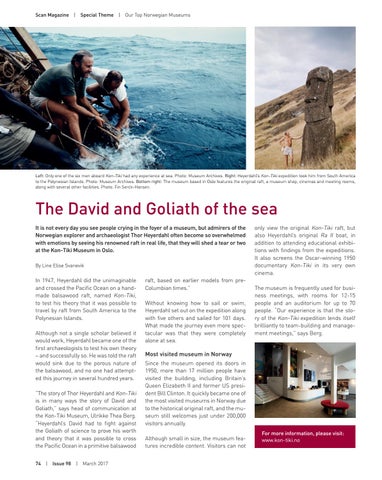Scan Magazine | Special Theme | Our Top Norwegian Museums
Left: Only one of the six men aboard Kon-Tiki had any experience at sea. Photo: Museum Archives. Right: Heyerdahl’s Kon-Tiki expedition took him from South America to the Polynesian Islands. Photo: Museum Archives. Bottom right: The museum based in Oslo features the original raft, a museum shop, cinemas and meeting rooms, along with several other facilities. Photo: Fin Serck-Hansen.
The David and Goliath of the sea It is not every day you see people crying in the foyer of a museum, but admirers of the Norwegian explorer and archaeologist Thor Heyerdahl often become so overwhelmed with emotions by seeing his renowned raft in real life, that they will shed a tear or two at the Kon-Tiki Museum in Oslo. By Line Elise Svanevik
In 1947, Heyerdahl did the unimaginable and crossed the Pacific Ocean on a handmade balsawood raft, named Kon-Tiki, to test his theory that it was possible to travel by raft from South America to the Polynesian Islands. Although not a single scholar believed it would work, Heyerdahl became one of the first archaeologists to test his own theory – and successfully so. He was told the raft would sink due to the porous nature of the balsawood, and no one had attempted this journey in several hundred years. “The story of Thor Heyerdahl and Kon-Tiki is in many ways the story of David and Goliath,” says head of communication at the Kon-Tiki Museum, Ulrikke Thea Berg. “Heyerdahl’s David had to fight against the Goliath of science to prove his worth and theory that it was possible to cross the Pacific Ocean in a primitive balsawood 74 | Issue 98 | March 2017
raft, based on earlier models from preColumbian times.” Without knowing how to sail or swim, Heyerdahl set out on the expedition along with five others and sailed for 101 days. What made the journey even more spectacular was that they were completely alone at sea.
only view the original Kon-Tiki raft, but also Heyerdahl’s original Ra II boat, in addition to attending educational exhibitions with findings from the expeditions. It also screens the Oscar-winning 1950 documentary Kon-Tiki in its very own cinema. The museum is frequently used for business meetings, with rooms for 12-15 people and an auditorium for up to 70 people. “Our experience is that the story of the Kon-Tiki expedition lends itself brilliantly to team-building and management meetings,” says Berg.
Most visited museum in Norway Since the museum opened its doors in 1950, more than 17 million people have visited the building, including Britain’s Queen Elizabeth II and former US president Bill Clinton. It quickly became one of the most visited museums in Norway due to the historical original raft, and the museum still welcomes just under 200,000 visitors annually. Although small in size, the museum features incredible content. Visitors can not
For more information, please visit: www.kon-tiki.no
